Lucky limit lures
Need five fish when nothing is working? Here are seven lures the pros use
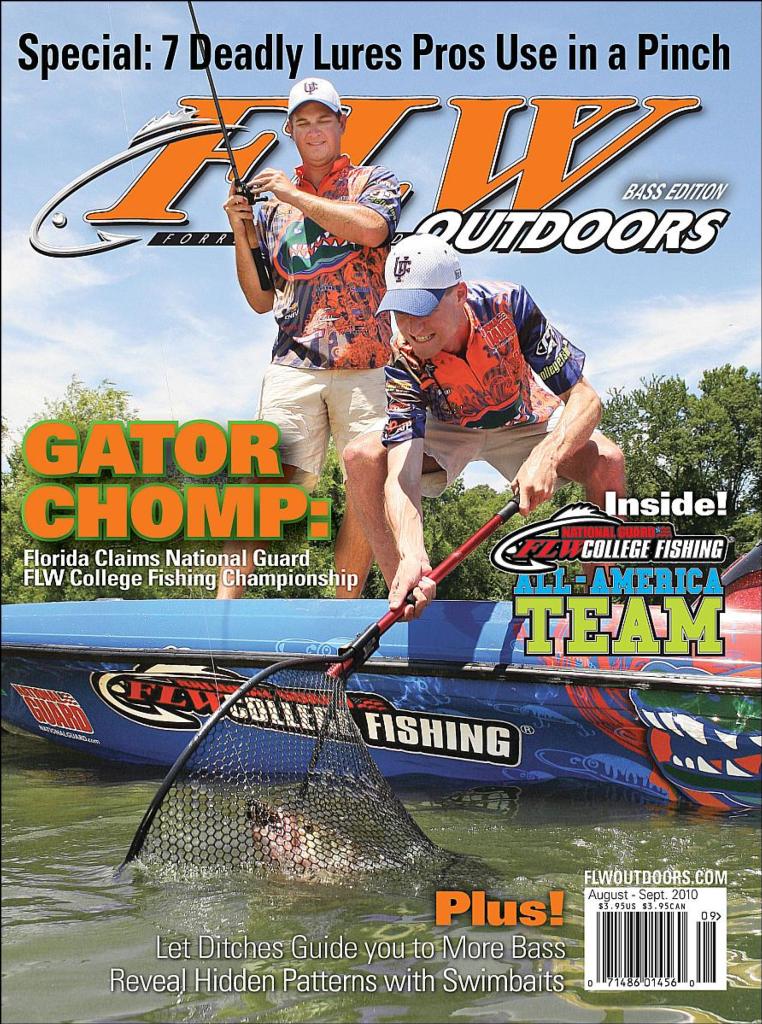
————————————–
Editor’s note: Ever wonder what lures the pros go to when they just need a limit? We break them down in this preview of the FLW Outdoors Magazine Bass Edition for August-September. And make sure to check out the rest of the in-depth articles when the magazine hits newsstands in a couple weeks. To learn more about the magazine and how to subscribe, click here.
————————————–
Every tournament fisherman dreams of catching a jaw-dropping sack of bass. The dream is sweetest, of course, when the catch comes on the final day of a major tournament, with hundreds of fans watching and thousands of dollars on the line.
The hard reality is that even accomplished professionals frequently struggle to catch five “keeper” bass, even small keepers. Yet, the difference between a small limit and a big zero can be the difference in winning and being forgotten. It can be the difference in cashing a check and eating the hotel bill. Come up shy of five bass too often and your career could even be in jeopardy.
That’s why pros always carry lucky limit lures in their tackle boxes. Invariably, one of them will be the shaky-head worm, which has become the standard for limit lures. However, the shaky head isn’t always the answer. Here are seven other limit lures that FLW Tour pros use to fill their livewells when they want to make sure their dreams don’t turn into nightmares.
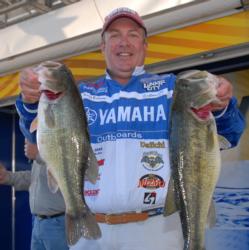 Pro: Terry Baksay
Pro: Terry Baksay
Hometown: Easton, Conn.
Lucky Limit Lure: Luhr Jensen Speed Trap
Baksay has yet to fish a body of water where he could not catch bass on a Luhr Jensen Speed Trap. The crankbait produces for him spring through fall and in clear to muddy water.
“If the bass are feeding on shad, alewives or anything like that, a Speed Trap does the job,” Baksay says.
Baksay compares the tight wiggle of the Speed Trap to that of the Rapala Shad Rap. That subtle action at slow speeds makes the lure effective in cold, early spring water, when many bass are reluctant to chase a wide-wobbling crankbait. A 1/8-ounce Speed Trap gets down to slightly less than 5 feet deep on a slow retrieve, making it a perfect option on staging points and flats in the cold months.
However, the lure was built for speed. And the rest of the year the 1/4-ounce Speed Trap and a faster mindset pay dividends.
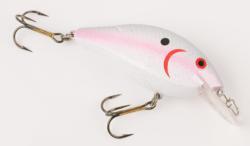 “I’ve done incredibly well with the Speed Trap in the summer and fall,” Baksay says. “It’s a great deflection lure for running through rock and wood cover.”
“I’ve done incredibly well with the Speed Trap in the summer and fall,” Baksay says. “It’s a great deflection lure for running through rock and wood cover.”
The ability to cover water and deflect off cover is exactly why the plug gets the call when nothing else is working. If Baksay can’t tempt five bites, then he can probably draw at least five reaction bites with the Speed Trap. And it can be cranked fast to cover water, increasing the chances of connecting with five willing fish.
That exact scenario played out for Baksay during a tournament at Old Hickory Lake. The pro failed to get on a good pattern during practice, so come the first day of the tournament he tied on a Speed Trap and started running and cranking. He ran the lure into every rock, riprap bank and shallow piece of wood cover he could see to boat a limit almost every day and garner a top-20 finish.
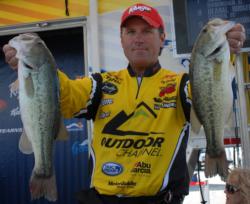 Pro: Joe Thomas
Pro: Joe Thomas
Hometown: Milford, Ohio
Lucky Limit Lure: Lucky Craft Pointer 78
You can’t overstate the confidence that Thomas has in a Lucky Craft Pointer 78.
“It’s amazing how that little jerkbait catches quick limits of bass,” he says.
Of course, if a lure produced a clutch limit the first time you tied it on, you probably would be fond of it too. Thomas was fishing a May tournament several years ago at Lake Guntersville and was in the top 10 going into the third and final day. With less than two hours left before weigh-in, the pro had only a few pounds of bass in his livewell.
Panicked, he ran to a shallow bay and found a milfoil bed. The bed topped out 2 to 3 feet under the surface in about 5 feet of water. Always fond of jerkbaits from his years of fishing smallmouths, he tied on the Pointer 78 and quickly twitched it over the grass with his rod tip held high. In little more than an hour, he was able to cull up to a 17-pound limit to take fifth place.
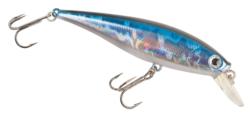 Since that time, Thomas has learned a lot more about why bass like the Pointer 78. Unlike lesser jerkbaits, the lure has a completely erratic action that walks back and forth under the water. At 3 inches long, the 78 model is small enough that bass of any size will attack it, which is perfect when trying to get those final limit fish.
Since that time, Thomas has learned a lot more about why bass like the Pointer 78. Unlike lesser jerkbaits, the lure has a completely erratic action that walks back and forth under the water. At 3 inches long, the 78 model is small enough that bass of any size will attack it, which is perfect when trying to get those final limit fish.
The Pointer 78 is especially deadly over submerged grass during the prespawn phase. But it can literally be thrown anywhere if needed, including around points, docks and wood. The only limiting factors are water clarity and water temperature. The Pointer 78 fares best in water with 2 feet or greater visibility and water temperatures ranging from the mid-50s to the mid-60s.
“My basic cadence is jerk, pause, jerk-jerk, pause,” Thomas says. “My pauses are one to two seconds when the water is creeping into the mid-50s, but I shorten the pauses as the water warms.”
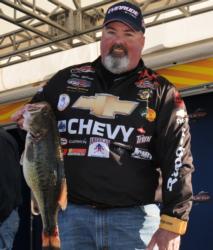 Pro: Chevy pro Dion Hibdon
Pro: Chevy pro Dion Hibdon
Hometown: Stover, Mo.
Lucky Limit Lure: Finesse jig and craw
Hibdon is known for his skill with finesse lures. So it’s no surprise that when he’s in desperate need of bites, Hibdon goes to his tiniest offering.
The Chevy pro’s go-to tidbit is a 1/8-ounce Luck “E” Strike ball-head jig with the skirt trimmed back to be even with the hook’s bend for the smallest silhouette. The jig is then adorned with a Luck “E” Strike Baby Guido Bug pinched down to half its size.
“If I don’t have any fish in the boat by noon, I strap on that little jig and go catch a limit,” Hibdon says.
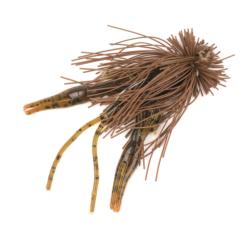
February through May is prime time for this lure, particularly at clear, rocky lakes that support smallmouth and spotted bass
“I also use it late in the fall when bass go on a crawdad feed,” Hibdon says. “In my part of the world, that happens around the end of October.”
The tactic is basically target casting to shallow cover like an angler would do with a wacky rig. Cast to boulders, logs, docks and any other shallow cover that looks like it would hold a bass. Let the jig sink to the bottom, and if nothing eats it on the way down, crawl it slowly around the piece of cover for a few feet before moving on to the next piece of cover.
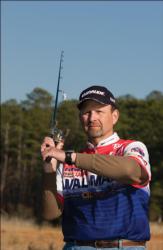 Pro: George Cochran
Pro: George Cochran
Hometown: Hot Springs, Ark.
Lucky Limit Lure: Strike King Mr. Money Crankbait
After 30 years of fishing bass tournaments, Cochran has had to scratch out limits more times than he’d like to remember. And for the last decade, the veteran has relied on a tiny crankbait that Strike King sells exclusively through Walmart to do so. It’s appropriately named Mr. Money.
“That little crankbait has saved my bacon time and time again,” Cochran says. “It’s a fish-catching dude.”
Cochran learned long ago that tournament fishing is a numbers game. He believes that on most bass 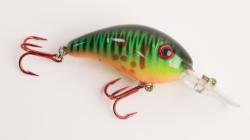 waters, 75 percent of the bass weigh 2 pounds or less. Thus, the small crankbait puts the odds of catching five keepers in his favor. Of course, Cochran occasionally dupes a heavyweight with it as well.
waters, 75 percent of the bass weigh 2 pounds or less. Thus, the small crankbait puts the odds of catching five keepers in his favor. Of course, Cochran occasionally dupes a heavyweight with it as well.
The tight-wiggling Mr. Money runs 4 to 5 feet deep. It fares best by casting it to bass that are suspended off points or in the mouths of pockets. Since the lure doesn’t bounce off the bottom in these situations, Cochran pauses during the retrieve every 10 to 15 feet.
“Some days they nail it when I stop, but most of the time they hit it on the move,” Cochran says.
While the lure looks too small to cast with baitcasting tackle, Cochran seems to have no trouble with a limber-tipped 7-foot RaZr baitcasting rod and 10-pound-test monofilament.
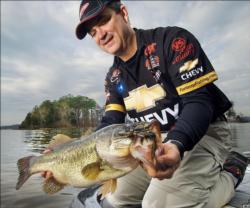 Pro: Chevy pro Jay Yelas
Pro: Chevy pro Jay Yelas
Hometown: Corvallis, Ore.
Lucky Limit Lure: Drop-shot
When most West Coast anglers get in jams, the finesse tactics come out. Sure enough, Yelas is no exception. The Chevy pro almost always has a drop-shot rigged up and within arm’s reach for when he’s struggling to fill his livewell.
“Drop-shotting really shines when bass are out on ledges, rock piles and other offshore structure,” Yelas says. “But I also do well with it around boat docks and in scattered grass.”
His usual rig consists of a 1/4-ounce drop-shot weight 8 to 10 inches below a No. 4 Mustad Dropshot Wide Gap Hook. In the middepth range of 10 to 30 feet of water, he casts the rig to structure like he would a worm or jig.
The presentation and rig varies with the depth. In deep water, he’ll beef up to a 3/8-ounce weight and 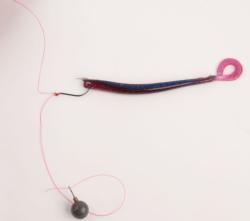 drop the rig vertically. Similarly, he’ll downsize to a 1/8-ounce weight whenever he is fishing shallower than 4 to 5 feet because it makes less of a splash and is less likely to spook a bass.
drop the rig vertically. Similarly, he’ll downsize to a 1/8-ounce weight whenever he is fishing shallower than 4 to 5 feet because it makes less of a splash and is less likely to spook a bass.
Lure-wise, Yelas nose hooks a 5-inch Berkley Powerbait Hand Poured Curl Tail Worm when he’s after finicky largemouths and spotted bass. On smallmouth waters, he switches to a 3-inch Berkley Gulp! Minnow.
The key to the drop-shot rig is its ability to tempt. Even a jig sitting motionless doesn’t tease a bass like a small soft plastic flitting and quivering a foot off the bottom. This can be a big thing when bass’ moods change, as they did on the third day of the 2009 FLW Tour event at Lake Champlain. Yelas had done well the first two days casting a 10-inch worm and a jig to scattered milfoil on a boulder-strewn bottom 7 to 8 feet deep. But by the third day of the tournament, the bass would barely touch the big lures.
“That’s when I started drop-shotting a worm,” Yelas says. “I was able to keep milking that school of bass and finished fourth.”
The key to getting bites with the drop-shot is to let the bait sink slowly to the bottom. Then Yelas lifts the bait slowly and lets it sink again.
“The worst thing you can do is overwork the bait,” Yelas says.
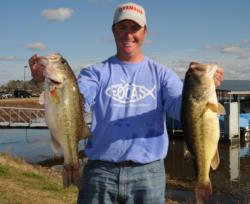 Pro: Scott Canterbury
Pro: Scott Canterbury
Hometown: Springville, Ala.
Lucky Limit Lure: Texas-Rigged Tube
There was a time when you couldn’t pry a flipping stick from the hands of Canterbury, a shallow-water specialist. The pro has since had to expand his fishing skills to compete successfully on the FLW Tour. However, when he needs a limit, he still goes back to the flipping stick, only nowadays with a different lure.
Canterbury’s principal flip-and-pitch lure is a 5/8-ounce jig. When he’s strapped for fish, he swaps the jig for a 4-inch Berkley PowerBait Pro Power Tube and a 3/8-ounce bullet sinker. He Texas rigs the tube with a 4/0 straight-shank Paycheck Baits hook, which he claims loses fewer bass than the offset, wide-gap hook most anglers use.
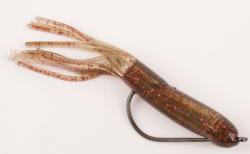
Normal pitching techniques still apply when fishing the tube, but Canterbury also throws in a new trick. If possible, he will intentionally drape the line over a piece of cover during the pitch. This creates a pivot point to yo-yo the lure in place. Not only can the presentation trigger a reaction bite on the initial fall, but the yo-yoing action of the tube can also tempt bass into biting.
The key to using the tube is still to cover water to find five keeper bites. Canterbury does this by spacing his pitches far apart and aiming for the sweet spot in every piece of cover – the thickest part of a laydown, the dark hole in a grass mat, the shadow of a boulder.
The tube also produces limits far away from cover. Instead of a crankbait, Canterbury hops a tube 12 to 16 inches above the bottom on hard structure such as points or bars. The tube twists and spins on the fall, which is often the spark bass need to bite.
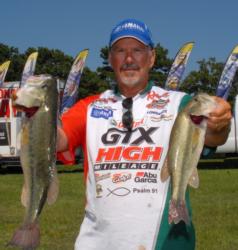 Pro: Darrel Robertson
Pro: Darrel Robertson
Hometown: Jay, Okla.
Lucky Limit Lure: Zoom Super Fluke
There is little hesitation from Robertson when asked what lure he goes to for a clutch limit: a Zoom Super Fluke. The soft-plastic jerkbait has long been a standby because of its ability to imitate a dying shad, and few meals are easier for a bass than a dying shad.
“You want to rig the Fluke so it falls flat like a dying shad would, not nose down,” says Robertson, who is third all time in FLW Outdoors earnings.
He does this by Texas rigging the lure with an offset 4/0 hook and fixing two adhesive lead strips to the 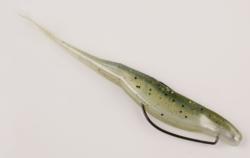 hook’s shank. What’s interesting about Robertson’s rig is that while he does catch fish twitching the lure, if he needs a limit he usually dead-sticks the Fluke by casting it and letting it shimmy straight down
hook’s shank. What’s interesting about Robertson’s rig is that while he does catch fish twitching the lure, if he needs a limit he usually dead-sticks the Fluke by casting it and letting it shimmy straight down
“I let the lure do all the work,” Robertson says.
The straight-fall technique works in a variety of settings, with a few modifications in technique depending on the area. In shallow cover, cast the rig and let it sink a couple of feet into the cover. That’s often all that is needed to get bit. If nothing bites, give it a twitch or two before casting to the next target.
For suspended bass, it’s better to count the lure down 5 to 7 feet over the school. If the water is clear enough, the fluttering jerkbait can draw bites from bass as far down as 30 feet deep.
Then there is always dead-sticking the Super Fluke over shallow, coverless areas, as Robertson did to finish fifth at the 2006 FLW Tour event at Beaver Lake. The pro located a rocky point where the wind had blown schools of shad up against the bank. The constant crashing and surging of the waves disoriented the baitfish. Bass feeding on them were tuned into the fluttering, falling shad and didn’t want a fast-moving lure. So instead, Robertson made hay with his Super Fluke by imitating the dying shad being sloshed around by the waves.
Basically, there are numerous ways to scratch out a limit or better with a Super Fluke, or any of the other lures on this list. Remember them come tournament time.